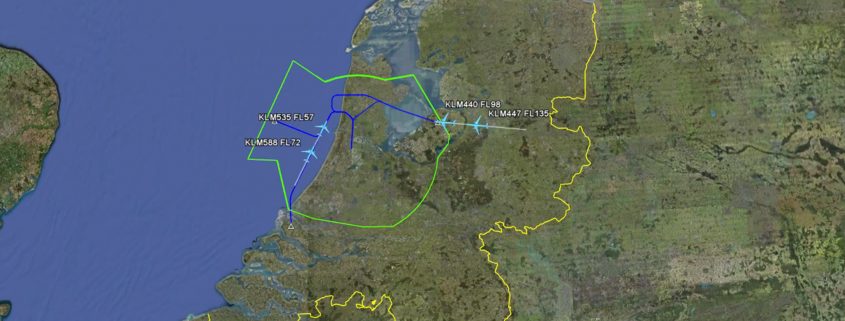A consortium including the National Aerospace Laboratory (NLR) KLM airlines and Air Traffic Control the Netherlands (LVNL) has successfully completed a test campaign for the SESAR Joint Undertaking (SJU). This so-called AIRE project involved testing a system that allows more Continuous Descent Approaches (CDA), or glide flights, to be uninterruptedly performed during peak hours of the night. The project team was supported by Delta Airlines, MUAC and NATS.
The AIRE project research team worked on developing a method that would allow aircraft to land according to tighter schedules, and thus also allow CDAs to be regularly scheduled , also during busy, peak hours. This is possible if the aircraft is controlled in a very early stage of the flight (60-90 minutes prior to landing). In order to devise an optimal schedule, the planning system communicates with the aircraft via a data link, requesting data from the aircraft’s flight computer. Based on this data, an optimal schedule is devised, which gives the aircraft a high probability of flying an undisturbed CDA.
In the consortium, NLR’s responsibilities included developing the system that collects data and facilitates communication between the stakeholders. The system then processes the data into an optimal schedule and retransmits this schedule back to the aircraft.
The SJU recently commented positively about the project results and has invited the consortium to continue its development. A promotional video was compiled from the live trials conducted on November 2011. In the video, an LVNL controller and a KLM pilot explain how the tests were conducted: watch here.
The participants in this consortium intend to continue the project. A possible next step involves improving the Estimated Time of Arrival (ETA) calculations for the aircraft by providing improved weather information. In addition, the Air Traffic Control (ATC) procedures can be tightened and improved, and the coordination procedures with surrounding centres, such as MUAC and NATS, can also be made more efficient. AIRE, which stands for ‘Atlantic Interoperability Initiative to Reduce Emissions’, is part of the European project SESAR (Single European Sky ATM Research), which, among its many objectives, aims to improve the ATM (Air Traffic Management) system and thus help reduce CO2 emissions in Europe by 10 percent.



